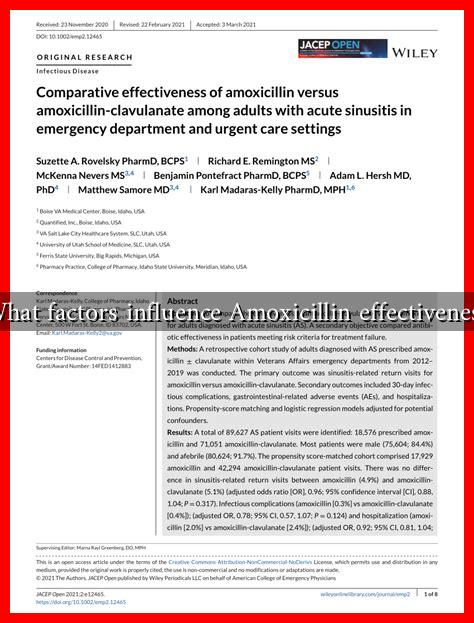-
Table of Contents
What Factors Influence Amoxicillin Effectiveness
Amoxicillin is a widely used antibiotic that belongs to the penicillin group. It is effective against a variety of bacterial infections, including those affecting the respiratory tract, urinary tract, and skin. However, the effectiveness of Amoxicillin can be influenced by several factors. Understanding these factors is crucial for both healthcare providers and patients to ensure optimal treatment outcomes.
1. Bacterial Resistance
One of the most significant factors affecting the effectiveness of Amoxicillin is bacterial resistance. Over time, some bacteria have developed mechanisms to resist the effects of antibiotics, including Amoxicillin. This resistance can occur due to:
- Overuse of Antibiotics: Frequent and inappropriate use of antibiotics can lead to the development of resistant strains.
- Incomplete Courses of Treatment: Patients who do not complete their prescribed antibiotic course may contribute to resistance.
- Use in Agriculture: The use of antibiotics in livestock can also lead to resistant bacteria that can be transmitted to humans.
According to the Centers for Disease Control and Prevention (CDC), antibiotic resistance is a growing public health concern, with at least 2.8 million antibiotic-resistant infections occurring each year in the United States alone.
2. Dosage and Administration
The dosage and method of administration of Amoxicillin can significantly impact its effectiveness. Key considerations include:
- Correct Dosage: The prescribed dosage must be appropriate for the type and severity of the infection. For instance, higher doses may be required for more severe infections.
- Timing of Doses: Taking the medication at evenly spaced intervals helps maintain effective drug levels in the bloodstream.
- Formulation: Amoxicillin is available in various forms, including tablets, capsules, and liquid suspensions. The choice of formulation can affect absorption rates.
For example, a study published in the Journal of Antimicrobial Chemotherapy found that patients who adhered to their prescribed dosing schedule experienced significantly better outcomes than those who did not.
3. Patient Factors
Individual patient characteristics can also influence the effectiveness of Amoxicillin. These factors include:
- Age: Children and elderly patients may metabolize drugs differently, affecting how Amoxicillin works in their bodies.
- Weight: Dosage may need to be adjusted based on a patient’s weight, particularly in pediatric cases.
- Comorbid Conditions: Patients with underlying health issues, such as liver or kidney disease, may require dosage adjustments.
For instance, a clinical trial published in the Pediatric Infectious Disease Journal highlighted that children with certain metabolic disorders may require alternative dosing strategies to achieve effective treatment outcomes.
4. Drug Interactions
Amoxicillin can interact with other medications, which may reduce its effectiveness or increase the risk of side effects. Some common drug interactions include:
- Probenecid: This medication can increase Amoxicillin levels in the blood, potentially leading to toxicity.
- Anticoagulants: Amoxicillin may enhance the effects of blood thinners, increasing the risk of bleeding.
- Oral Contraceptives: Some studies suggest that Amoxicillin may reduce the effectiveness of hormonal contraceptives.
Patients should always inform their healthcare providers about all medications they are taking to avoid potential interactions.
Conclusion
In summary, the effectiveness of Amoxicillin is influenced by a variety of factors, including bacterial resistance, dosage and administration, patient characteristics, and drug interactions. Understanding these factors is essential for optimizing treatment and combating antibiotic resistance. As healthcare providers and patients work together to ensure appropriate use of antibiotics, they can help preserve the effectiveness of Amoxicillin and other vital medications for future generations.
For more information on antibiotic resistance and its implications, visit the CDC’s Antibiotic Resistance page.

